
Free Vs. Paid Apps – Which Is More Profitable?
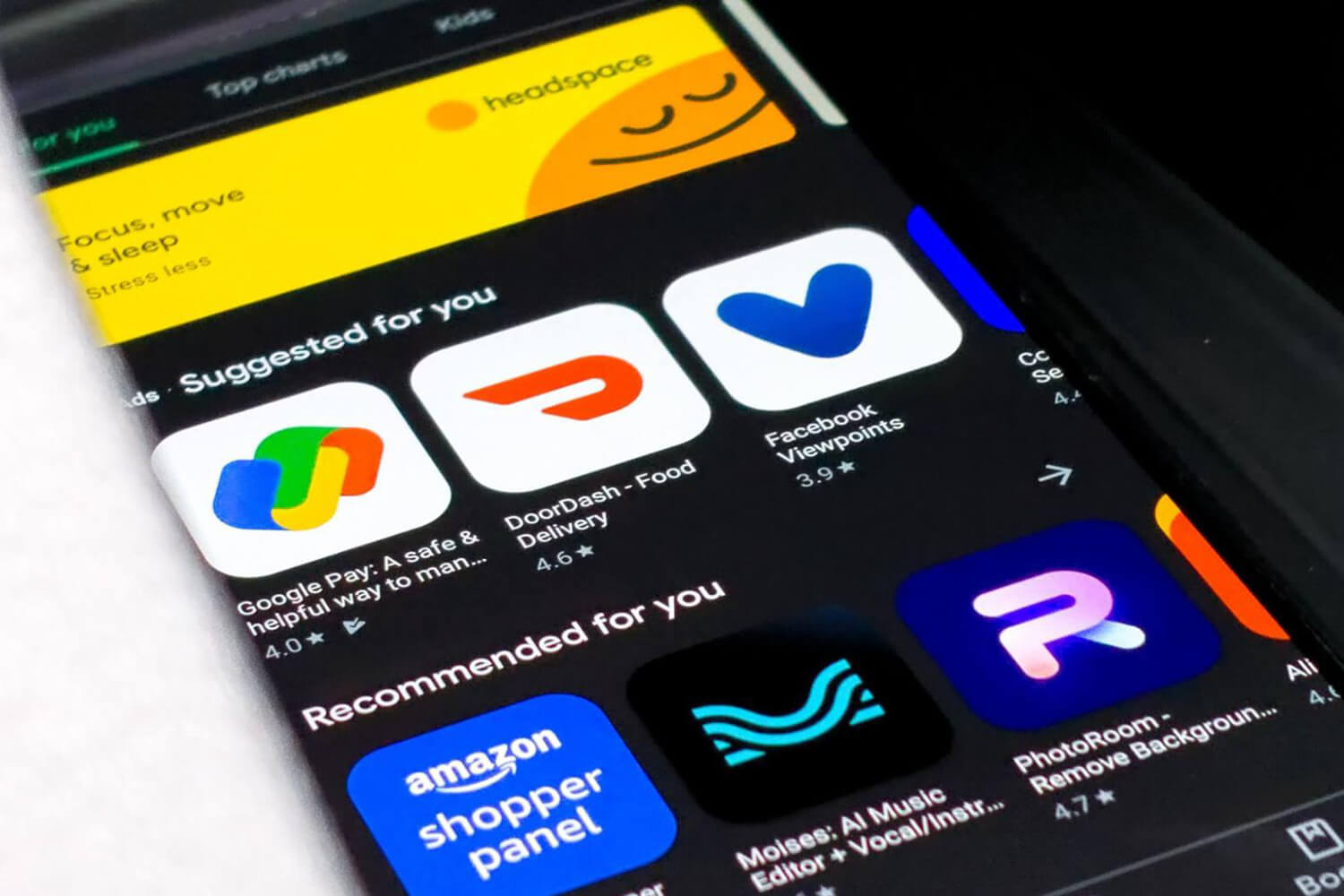
Table of Contents
- Market Share
- App Monetization Strategies
- How Free Apps Generate Revenue
- #1: In-App Advertising
- #2: In-App Purchases
- #3: Subscriptions
- #4: Selling Merchandise
- #5: Sponsorships
- #6: Collecting and Selling Data
- How Paid Apps Generate Revenue
- #1: App Purchase
- #2: Freemium Upsell
- How Free Apps Generate Revenue
- Profit – Which Makes More Money?
- How To Choose The Best App Monetization Model
- #1: Define The Mobile App’s Business Goals
- #2: Consider The Mobile App’s Target Audience
- #3: Understand Who Is Willing To Pay More
- #4: Assess Your Competitors
- #5: Test The Mobile App Monetization Strategies
- Key Takeaway
They say the best things in life are free: a breath of fresh air, uncontrollable laughter, and downloading free apps (obviously). In fact, as the market for apps continues to grow, we’ve noticed that app publishers are now increasingly prioritizing free apps as opposed to paid apps.
That’s the trend at the moment across the Apple App Store and Google Play Store.
Come to think of it, though, let’s be honest. As an app developer who intends to make money from your mobile app, free isn’t exactly what you might have in mind. App publishers, app owners, and app developers are always tempted to go for premium apps, as they provide a very straightforward revenue generation model.
App users, on the other hand, are overwhelmingly pulled by the allure of free apps. Yes, let’s face it – even you would admit to downloading way more free apps from the App Store than paid apps.
As such, it’s understandable why you might be torn between proceeding with a freemium model, or maybe publishing the app as a premium one.
Which of the two stands to generate more app revenue for your businesses? Or rather, which is more profitable between free apps and paid apps?
This article settles the debate by providing the facts as they are. You get to find out:
- How free apps and paid apps are performing in the Apple App Store and Google Play Store.
- The market shares are enjoyed by freemium apps and premium apps.
- All the app monetization options for both free and paid apps.
- The popular app monetization models.
- Which generates more revenue between free apps and paid apps.
- How to choose the best app monetization strategy for your business.
Market Share
In terms of volume, it turns out paid apps are substantially overshadowed by free apps.
As of March 2021, data published by Statista Research Department showed that 92.9% of iOS apps in the Apple App Store and 96.7% of Android apps in the Google Play Store were free.
Now that’s a huge gap between the two. And get this – it’s not reducing anytime soon, as recent trends demonstrate that mobile app developers continue to publish far more free apps than premium mobile apps.
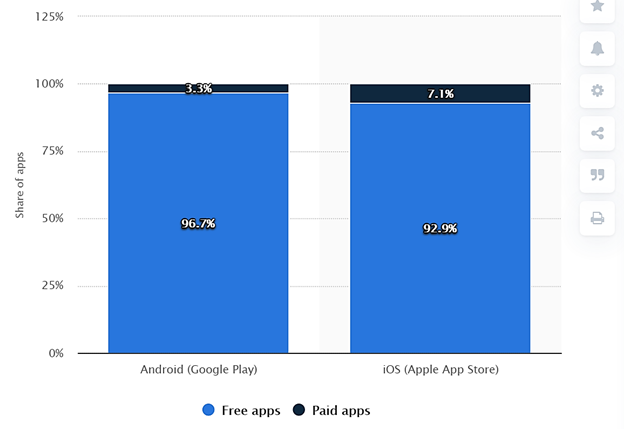
In June 2019, for instance, free apps in the Google Play Store and Apple App Store enjoyed a combined market share of 95.6%, while paid apps could only manage 4.4%. Compare that to March 2021 figures, which placed free apps at 96.7% and paid apps at 3.3%.
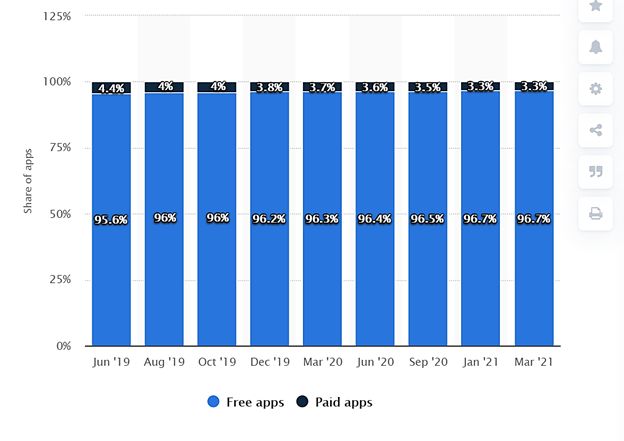
So, it’s safe to conclude that app publishers are increasingly ditching premium apps for their freemium counterparts.
Why, you ask?
Well, here’s the thing. The trend has largely been triggered by preferences among app users. Whether you like it or not, mobile app users overwhelmingly prefer free apps over paid apps. So much so that, according to research conducted by Google and Ipsos, 1 in 2 smartphone users in the U.S. have never paid for an app.
Ok, now where does that place freemium and premium app owners? How have they been able to generate revenue all these years?
App Monetization Strategies
How Free Apps Generate Revenue
The truth of the matter is, there’s really no such thing as a free mobile app. While the download process itself might be free, mobile apps cleverly utilize various monetization models to generate revenue from users.
6 of the most commonly used app monetization strategies (for free apps) are:
- App advertising
- In-app purchases
- Subscriptions
- Selling merchandise
- Sponsorships
- Collecting and selling data
Let’s look into each of them in detail…
#1. In-App Advertising
In-app advertising happens to be one of the easiest app monetization models to implement. You just need to find a way to display ads within your mobile app, and revenue will start streaming in from third-party ad networks.
By 2019, mobile advertising was attracting spending of 189 billion U.S. dollars. The trend continues to grow, and experts project that it’ll surpass 240 billion U.S. dollars by 2025.
So, yes – there’s a lot of money to make here if you attract a sizable number of mobile app users.

Now, to be specific, app owners typically get paid based on the number of ad impressions, the volume of ad clicks, or the number of conversions made through the ads.
If that sounds like something you’d want to try out, there are 4 primary types of ads you could build into your mobile app:
- Native Ads: Just like the name suggests, native ads are embedded to appear as a natural element of the app. They intend to promote a relevant product or mobile app, usually as part of an affiliate marketing arrangement.
The good thing about native ads is, app users themselves find them to be less intrusive than other monetization methods that rely on ads. On the flip side, though, it turns out native ads generate less ad revenue compared to other types of ads.
- Banner Ads: These are basically displayed as banners within the mobile app layout. They mostly appear at the top or bottom sections of the screen, leaving app users to work with the rest of the mobile app interface.
- Interstitial Ads: Interstitial ads are full-screen pop-ups that appear occasionally as users interact with the mobile app. They also come with a close button on the upper right or left corner of the screen.
- In-App Reward Video Ads: These are special video ads that offer app users various rewards once they view them. You could, for instance, set your gaming app to unlock additional features for users who choose to watch video ads.
This app monetization model is known to have far better retention rates than other types of app advertisements.
#2. In-App Purchases
In-app purchases are built to give app users the option of buying extra features for a fee. The apps themselves can be downloaded and used to a certain extent for free, after which users are requested to pay in order to unlock additional capabilities.
This monetization strategy is particularly common among free mobile game apps, where in-app purchases are typically used to access special “power-ups” or extra gaming levels.
You’ve probably seen it in action on apps like Angry Birds or Clash of Clans. While the games themselves are free of charge, they allow players to purchase various virtual items for enhanced gameplay.
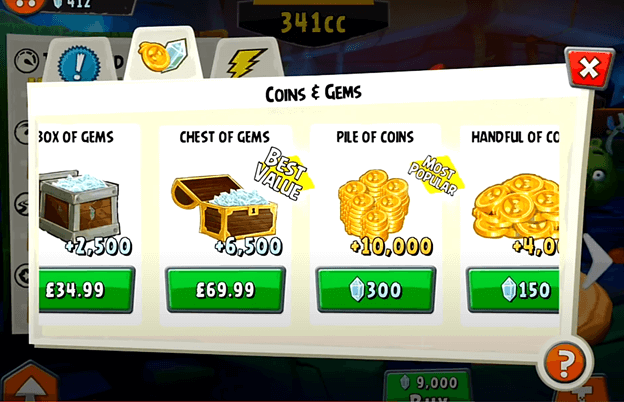
This is a thoughtful way of generating revenue from your mobile app without being too intrusive. App users have, in fact, been responding much more positively to in-app purchases than other types of app monetization options. That’s why, according to Forbes, mobile apps with in-app purchases generate the highest revenue for app owners.
#3. Subscriptions
Apart from mobile app advertising and in-app purchases, you could strategically use subscriptions as a monetization strategy. The trick here is to provide free content on your mobile app for a limited period of time, and then request users to pay a subscription fee in exchange for full content access privileges.
In particular, this monetization model is mostly leveraged by apps that specialize in audio streaming, video streaming, cloud services, and news.
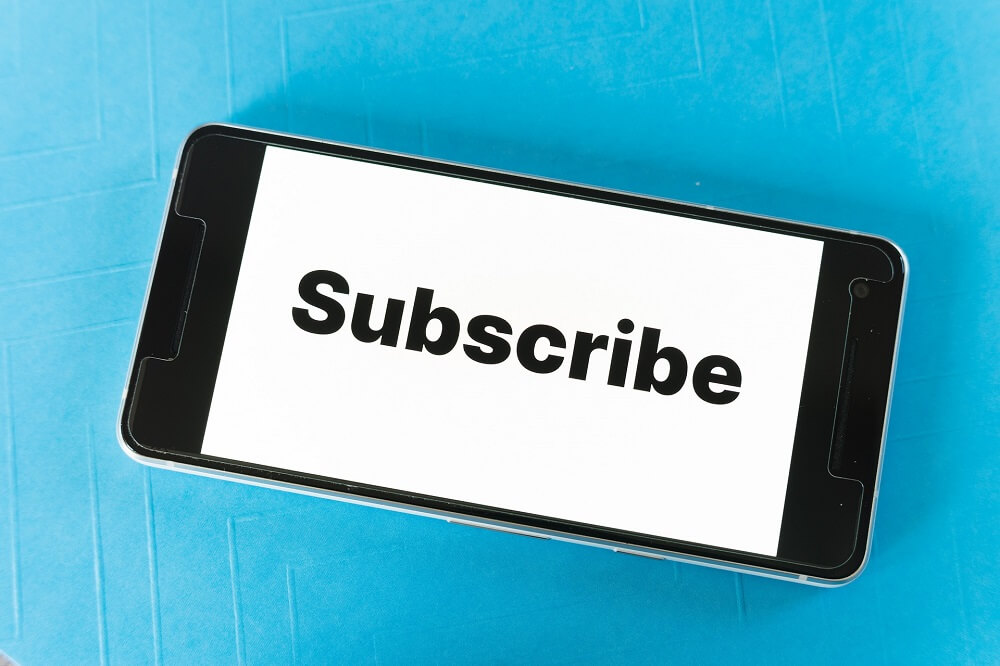
Take Netflix, for example. Once you download the app for free, it allows you to proceed with watching videos for a month or so. Then when the trial period lapses, you’ll be required to subscribe to one of its premium plans to continue accessing the content.
If you choose to build a similar subscription-based app for iOS users, you’ll be pleased that Apple doesn’t take that much from the revenue kitty. While the company continues to deduct a commission of 30% from in-app purchases, it sweetened the deal for subscription-based apps by reducing its revenue share to 15%.
Please note, however, that this only applies after the first year of subscription. So, expect to split your first-year subscription payments 70/30.
#4. Selling Merchandise
It’s also possible to generate revenue from your free mobile app by selling different types of merchandise.
This monetization strategy is particularly common among eCommerce businesses that rely on product sales. Instead of monetizing the app itself, they choose to offer a free version through the App Store, which users then proceed to shop with.
The Amazon app is a great example of one. While you’ll never pay to use the app, Amazon manages to generate revenue from all your merchandise shopping.
#5. Sponsorships
Although it’s not very popular, the sponsorship model packs a lot of revenue generation potential for well-connected app developers. You just need to find yourself a sponsor in your niche and then come up with a sponsorship deal that serves both parties.
You could, for instance, strike up a deal with nutrition brands to run sponsored content on your fitness app. They’d be willing to pay you to perhaps popularize their brands, market their products, or probably send leads to their website.
#6. Collecting and Selling Data
One thing about mobile apps is, they always gather a lot of user data on behaviors, personal interests, and app usage. This is valuable information, as some advertisers and platforms are willing to pay top dollar to tap it.
You can, for instance, set your mobile app to track user activity, and then sell the data to third-party researchers and marketers. Alternatively, you could simply forward user details like personal preferences, social media accounts, and email addresses.

But, while you’re at it, you might want to take extra caution. User data should only be shared with other parties after getting a go-ahead from the users themselves. That’s why it’s very important to have them accept the terms and conditions before using the app.
How Paid Apps Generate Revenue
Paid apps, on the other hand, rely on these two revenue generation models:
- App purchase
- Freemium Upsell
#1. App Purchase
The first monetization strategy is the most obvious. Create an amazing app, charge consumers for your amazing app and you’re done.
Both Google Play Store and Apple App Store allow app publishers to set their app purchase prices. You could, for example, make your app available for even as low as $0.99. It all depends on the value you’ve attached to your app, plus its target market.
As of January 2021, the Apple App Store had more than 38,000 mobile apps that cost less than a dollar. That was pretty much the same trend across the Google Play Store, as its paid apps by then had a combined average price of less than $1.
It’s worth noting, though, a study at Cambridge University showed that just 20% of paid apps are downloaded more than 100 times and only 0.2% of paid apps are downloaded more than 10,000 times.
So even if you are assured to receive that $0.99 from every download, having your customers pay for your app directly will not necessarily bring in the biggest profits.
#2. Freemium Upsell
Another great monetization strategy to explore is known as the freemium model. Under this framework – which dates back to 1994, according to Forbes Magazine – companies and developers offer a free and a paid version of their app to consumers.
The whole thing works because it allows users to test out the free version before deciding for themselves. If they like what they see, they might commit to buying the paid version of the app – which, in most cases, comes with superior features.
In an interview with USA Today, the Executive Producer at developer XMG Studio, Ross Dixon, explained that:
“People are willing to invest their time — rather than money — to try out a new app.” He says, “if [users] like it, some will pay for additional content.”
So, in essence, you could say the freemium version is great at increasing downloads and generating reviews for your mobile app, while the premium version is ideal for revenue generation.
Profit – Which Makes More Money?
And now for the big reveal. Which is more profitable between free apps and paid apps?
Now, to provide a conclusive answer, let’s review the most recent market figures.
In 2020, the Google Play Store and Apple App Store managed to generate a combined revenue of $111 billion from their mobile apps. IOS apps, despite attracting fewer downloads than their Android counterparts, performed better overall – as they accounted for 65% of the total mobile app revenue in 2020.
Why is that?
Well, as it turns out, the average monthly in-app spending per app for each iOS user is $1. Android app users, on the other hand, have average monthly spending of $0.43 per user, per app.
This makes a huge difference in the total revenue generated because, in the end, in-app purchases alone account for 48.2% of mobile app earnings. Revenue from app advertisement, on the other hand, adds up to 14%, while paid app downloads account for 37.8% of the earnings.
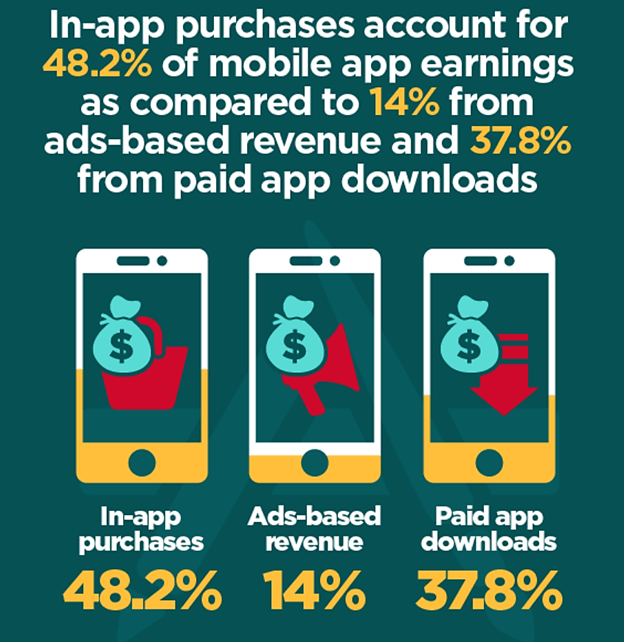
If we cross over to the top earners, TikTok emerged as the highest-grossing mobile app worldwide in 2020. In the first half of the year, it had made more than $433 million across the Apple App Store and Google Play Store.
Then in 2021, figures sampled from the Google Play Store in April showed that Coin Master was at the top globally with $61.02 million in earnings, followed by Garena Free Fire – World Series with $38.56 million, and PUGB MOBILE – KARAKIN with $37.76 million.
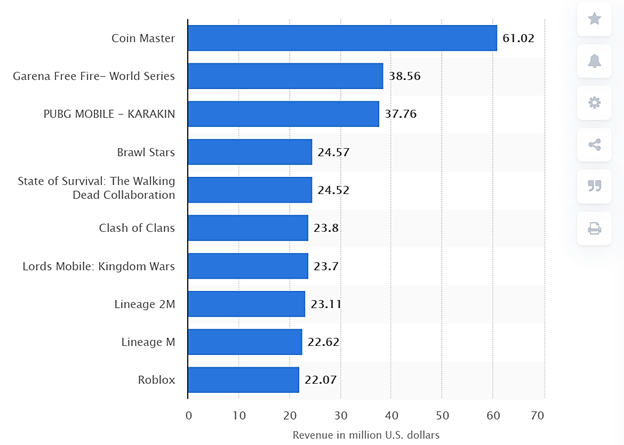
By now, you should have noticed the obvious trend – that free mobile apps just happen to generate much more revenue than their premium counterparts.
If you take a look at the top-earning charts across the Apple Play Store and Google Play Store, you’ll notice that they’re both dominated by free apps. The same applies to the overall revenue statistics – mobile apps are making the bulk of their money from in-app purchases.
This revenue dominance has a lot to do with the fact that free apps are not only overwhelmingly popular but also offer a far much wider range of app monetization options. If in-app ads are not working for you, you could alternatively settle for in-app purchases, subscriptions, sponsorships, merchandise sales, or data selling.
But then again, don’t be quick to write off paid mobile apps. 37.8% of the total app revenue is no joke, especially when you consider the fact that the market share of paid apps is less than 4%.
And what does that mean?
Well, quite simply, you stand to benefit from both paid apps and free apps. Either of them can work fine for you – it all depends on your specific circumstances. That means you ought to critically review not just the overall paid vs free apps market figures, but also the specific conditions surrounding your upcoming mobile app.
Here’s a brief guide to help you with that…
How To Choose The Best App Monetization Model
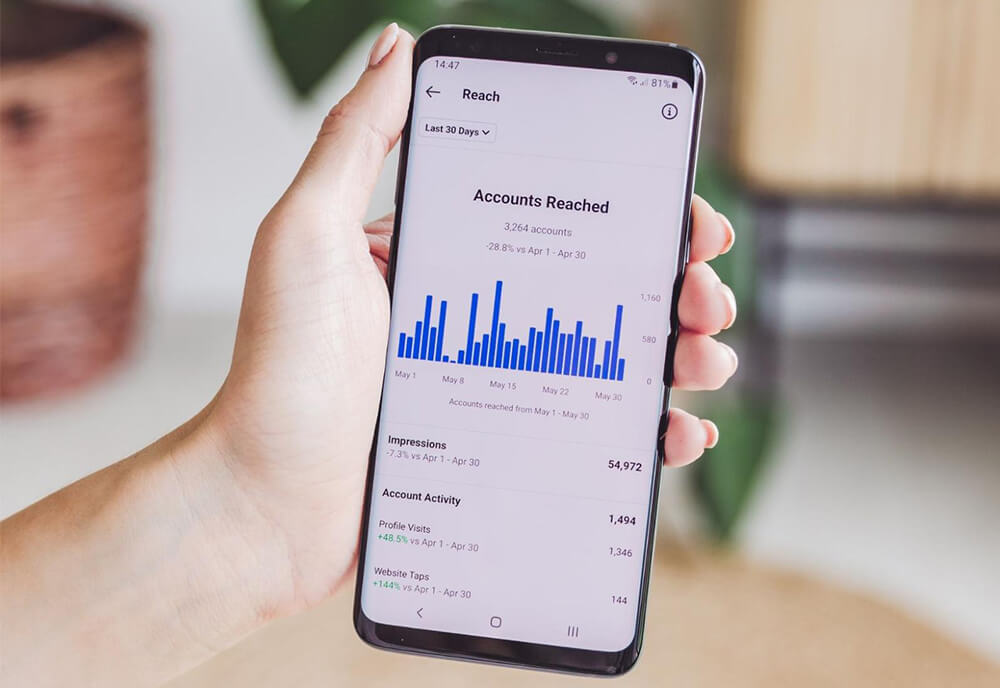
#1. Define The Mobile App’s Business Goals
To determine the best monetization model for your mobile app, you need to start by defining what exactly you intend to achieve in terms of business goals.
In other words, what do you consider to be the biggest priority for your business right now? Are you seeking to build revenue or simply gain mobile app users? Is your business interested in promoting its brand by attracting as many downloads as possible, or would you be comfortable with fewer downloads but a higher conversion rate per user?
If you’re looking to generate quick revenue from the mobile app, then you might want to consider proceeding with a free app that makes money from in-app advertising.
The subscription-based monetization strategy, on the other hand, is best left to businesses that have already built a decent customer base way before launching a supplementary mobile app.
#2. Consider The Mobile App’s Target Audience
Apart from your business goals, you should consider the type of audience that you’ll be targeting with your mobile app. Some of these app monetization models have been shown to work best with certain groups of users, but then end up performing dismally with others.
For instance, a gaming app will have an audience that won’t necessarily mind in-app advertisements. Mobile gamers will simply ignore the advertising or click through onto other games and apps.
In contrast, a business app will have a more professional audience that is likely to find in-app advertisements annoying and distracting to their experience.
So, before anything else, try to determine the purpose of your app and its audience,
#3. Understand Who Is Willing To Pay More
In the free vs paid apps debate, it is important to keep in mind who pays for what. While paid apps are directly paid for by hesitant consumers, free apps are most commonly paid for by companies in the form of advertisements.
Unlike app users, companies are eager to spend on app advertisements. In fact, as users are increasingly choosing to download free apps, ad spending on apps is growing immensely.
#4. Assess Your Competitors
If you’d like to compete fairly against millions of other mobile apps in the market, then you need to understand your competition before taking the plunge. This is particularly critical for mobile app developers who are planning to venture into an already crowded mobile app niche.
You should take the time to analyze your app industry and the main competitors you’ll be facing once the app launches. Review not only their monetization strategies and options but also their corresponding weaknesses and strengths.
Are your competitors offering free or paid mobile apps? What types of app advertisements are the freemium competitors running? Which extra features do they offer on their premium mobile apps? How are their users responding to the monetization experiences?
A comprehensive analysis here might take you months, but it’s ultimately worth the effort. You get to not only understand the risks but also identify opportunities that you could capitalize on in your app’s monetization strategy.
#5. Test The Mobile App Monetization Strategies
There’s only one way to accurately counter-check the suitability of your selected app monetization model. Yes, that’s right – you need to run it through the very audiences that you intend to target.
More specifically, you ought to come up with various prototypes of your app during the beta development stage. Integrate different monetization models into them and then distribute the prototypes among your target users.
Ultimately, you’ll be able to track the response and usage patterns, as well as collect feedback from the app users. You can then combine all that to make an informed decision about the best monetization strategy for your app.
Key Takeaways
While everything we’ve discussed so far is important, here are the most critical pointers to keep in mind:
- As of March 2021, data published by Statista Research Department showed that 92.9% of iOS apps in the Apple App Store and 96.7% of Android apps in the Google Play Store were free.
- In June 2019, free apps in the Google Play Store and Apple App Store enjoyed a combined market share of 95.6%, while paid apps could only manage 4.4%. Compare that to March 2021 figures, which placed free apps at 96.7% and paid apps at 3.3%.
- Mobile app users overwhelmingly prefer free apps over paid apps. So much so that, according to research conducted by Google and Ipsos, 1 in 2 smartphone users in the U.S. have never paid for an app.
- 6 of the most commonly used app monetization strategies (for free apps) are App advertising; In-app purchases; Subscriptions; Selling merchandise; Sponsorships; Collecting and selling data.
- By 2019, mobile advertising was attracting spending of 189 billion U.S. dollars. The trend continues to grow, and experts project that it’ll surpass 240 billion U.S. dollars by 2025.
- There are 4 primary types of ads you could build into your mobile app: Native Ads; Banner Ads; Interstitial Ads; In-App Reward Video Ads.
- In-app purchases are built to give app users the option of buying extra features for a fee.
- According to Forbes, mobile apps with in-app purchases generate the highest revenue for app owners.
- The Subscription strategy provides free content on your mobile app for a limited period of time, after which it requests users to pay a subscription fee in exchange for full content access privileges.
- When it comes to the Sponsorship model, you just need to find yourself a sponsor in your niche and then come up with a sponsorship deal that serves both parties.
- Paid apps, on the other hand, rely on these two revenue generation models: App Purchase; Freemium Upsell.
- As of January 2021, the Apple App Store had more than 38,000 mobile apps that cost less than a dollar. That was pretty much the same trend across the Google Play Store, as its paid apps by then had a combined average price of less than $1.
- A study at Cambridge University showed that just 20% of paid apps are downloaded more than 100 times and only 0.2% of paid apps are downloaded more than 10,000 times.
- Freemium upsell allows users to test out the free version before deciding for themselves. If they like what they see, they might commit to buying the paid version of the app – which, in most cases, comes with superior features.
- In 2020, the Google Play Store and Apple App Store managed to generate a combined revenue of $111 billion from their mobile apps.
- The average monthly in-app spending per app for each iOS user is $1. Android app users, on the other hand, have average monthly spending of $0.43 per user, per app.
- In the end, in-app purchases alone account for 48.2% of mobile app earnings. Revenue from app advertisement, on the other hand, adds up to 14%, while paid app downloads account for 37.8% of the earnings.
- TikTok emerged as the highest-grossing mobile app worldwide in 2020. In the first half of the year, it had made more than $433 million across the Apple App Store and Google Play Store.
- Free apps dominate in revenue generation because free apps are not only overwhelmingly popular but also offer a far much wider range of app monetization options.
- To choose the best monetization methods for your app, you should: Define The Mobile App’s Business Goals; Consider The Mobile App’s Target Audience; Understand Who Is Willing To Pay More; Assess Your Competitors; and Test The Mobile App Monetization Strategies.
Conclusion
Developing an app is hard work, and making money from the app is not much easier. Free apps do not blindly bring in greater profits than paid apps do – as there is no definite right or wrong monetization strategy to make sure all apps make a profit.
The trick, rather, lies in choosing the right monetization model for your industry and the kind of app you’re offering. That’s why some savvy entrepreneurs even design their apps after choosing a monetization strategy, instead of vice-versa.
All in all, combining the right monetization model with strategic mobile app marketing will get your app noticed and keep the revenue rolling in.
You just worry about app development plus monetization – and we’ll take care of all the app marketing and promotion processes like we’ve done over a decade now.
So, go ahead and contact us today. We’ll set up an appropriate mobile app marketing plan based on your growth aspirations and monetization models.
Newsletter
Don’t miss a thing! Sign up to receive daily news
Subscribe Newsletter







